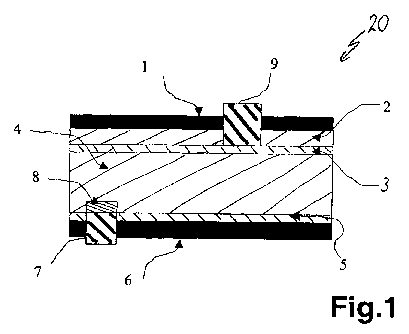Une partie des informations de ce site Web a été fournie par des sources externes. Le gouvernement du Canada n'assume aucune responsabilité concernant la précision, l'actualité ou la fiabilité des informations fournies par les sources externes. Les utilisateurs qui désirent employer cette information devraient consulter directement la source des informations. Le contenu fourni par les sources externes n'est pas assujetti aux exigences sur les langues officielles, la protection des renseignements personnels et l'accessibilité.
L'apparition de différences dans le texte et l'image des Revendications et de l'Abrégé dépend du moment auquel le document est publié. Les textes des Revendications et de l'Abrégé sont affichés :
| (12) Demande de brevet: | (11) CA 2679685 |
|---|---|
| (54) Titre français: | PROCEDE DE FABRICATION D'UNE CELLULE SOLAIRE ET CELLULE SOLAIRE AINSI FABRIQUEE |
| (54) Titre anglais: | METHOD FOR THE MANUFACTURE OF A SOLAR CELL AND THE RESULTING SOLAR CELL |
| Statut: | Réputée abandonnée et au-delà du délai pour le rétablissement - en attente de la réponse à l’avis de communication rejetée |
| (51) Classification internationale des brevets (CIB): |
|
|---|---|
| (72) Inventeurs : |
|
| (73) Titulaires : |
|
| (71) Demandeurs : |
|
| (74) Agent: | NORTON ROSE FULBRIGHT CANADA LLP/S.E.N.C.R.L., S.R.L. |
| (74) Co-agent: | |
| (45) Délivré: | |
| (86) Date de dépôt PCT: | 2008-03-04 |
| (87) Mise à la disponibilité du public: | 2008-09-12 |
| Licence disponible: | S.O. |
| Cédé au domaine public: | S.O. |
| (25) Langue des documents déposés: | Anglais |
| Traité de coopération en matière de brevets (PCT): | Oui |
|---|---|
| (86) Numéro de la demande PCT: | PCT/EP2008/001702 |
| (87) Numéro de publication internationale PCT: | WO 2008107156 |
| (85) Entrée nationale: | 2009-09-01 |
| (30) Données de priorité de la demande: | ||||||
|---|---|---|---|---|---|---|
|
L'invention concerne un procédé de fabrication d'une cellule solaire (20). Sur la face avant et la face arrière d'un substrat en silicium (4), on applique d'abord une première couche anti-réflexion (2, 5) ayant un indice de réfraction optique n compris entre 3,6 et 3,9. On applique sur cette couche une deuxième couche anti-réflexion (1, 6) ayant un indice de réfraction optique n compris entre 1,94 et 2,1. Les couches anti-réflexion (1, 2, 5, 6) sont sectionnées jusqu'au substrat en silicium (4), pour amener des contacts métalliques (7, 9) jusqu'au substrat en silicium (4).
In a method for producing a solar cell (20) from a silicon substrate (4), a first anti-reflective layer (2, 5) having an optical refraction index n between 3.6 and 3.9 is first applied to the front and back. Then a second anti-reflective layer (1, 6) having an optical refraction index n between 1.94 and 2.1 is applied thereon. The anti-reflective layers (1, 2, 5, 6) are severed down to the silicon substrate (4) underneath in order to insert metal contacts (7, 9) to the silicon substrate (4) therein.
Note : Les revendications sont présentées dans la langue officielle dans laquelle elles ont été soumises.
Note : Les descriptions sont présentées dans la langue officielle dans laquelle elles ont été soumises.

2024-08-01 : Dans le cadre de la transition vers les Brevets de nouvelle génération (BNG), la base de données sur les brevets canadiens (BDBC) contient désormais un Historique d'événement plus détaillé, qui reproduit le Journal des événements de notre nouvelle solution interne.
Veuillez noter que les événements débutant par « Inactive : » se réfèrent à des événements qui ne sont plus utilisés dans notre nouvelle solution interne.
Pour une meilleure compréhension de l'état de la demande ou brevet qui figure sur cette page, la rubrique Mise en garde , et les descriptions de Brevet , Historique d'événement , Taxes périodiques et Historique des paiements devraient être consultées.
| Description | Date |
|---|---|
| Inactive : CIB attribuée | 2015-12-18 |
| Inactive : CIB en 1re position | 2015-12-18 |
| Inactive : CIB expirée | 2014-01-01 |
| Inactive : CIB enlevée | 2013-12-31 |
| Demande non rétablie avant l'échéance | 2012-03-05 |
| Le délai pour l'annulation est expiré | 2012-03-05 |
| Réputée abandonnée - omission de répondre à un avis sur les taxes pour le maintien en état | 2011-03-04 |
| Lettre envoyée | 2010-01-19 |
| Inactive : Lettre officielle | 2010-01-19 |
| Inactive : Page couverture publiée | 2009-11-19 |
| Inactive : Transfert individuel | 2009-11-16 |
| Inactive : Déclaration des droits - PCT | 2009-11-16 |
| Inactive : Lettre de courtoisie - PCT | 2009-10-23 |
| Inactive : Notice - Entrée phase nat. - Pas de RE | 2009-10-23 |
| Inactive : CIB en 1re position | 2009-10-22 |
| Demande reçue - PCT | 2009-10-21 |
| Exigences pour l'entrée dans la phase nationale - jugée conforme | 2009-09-01 |
| Demande publiée (accessible au public) | 2008-09-12 |
| Date d'abandonnement | Raison | Date de rétablissement |
|---|---|---|
| 2011-03-04 |
Le dernier paiement a été reçu le 2010-02-04
Avis : Si le paiement en totalité n'a pas été reçu au plus tard à la date indiquée, une taxe supplémentaire peut être imposée, soit une des taxes suivantes :
Veuillez vous référer à la page web des taxes sur les brevets de l'OPIC pour voir tous les montants actuels des taxes.
| Type de taxes | Anniversaire | Échéance | Date payée |
|---|---|---|---|
| Taxe nationale de base - générale | 2009-09-01 | ||
| Enregistrement d'un document | 2009-11-16 | ||
| TM (demande, 2e anniv.) - générale | 02 | 2010-03-04 | 2010-02-04 |
Les titulaires actuels et antérieures au dossier sont affichés en ordre alphabétique.
| Titulaires actuels au dossier |
|---|
| SCHMID TECHNOLOGY SYSTEMS GMBH |
| Titulaires antérieures au dossier |
|---|
| S.O. |